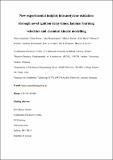| dc.contributor.author | Lokachari, Nitin | |
| dc.contributor.author | Burke, Ultan | |
| dc.contributor.author | Ramalingam, Ajoy | |
| dc.contributor.author | Turner, Mattias | |
| dc.contributor.author | Hesse, Raik | |
| dc.contributor.author | Somers, Kieran P. | |
| dc.contributor.author | Beeckmann, Joachim | |
| dc.contributor.author | Heufer, Karl A. | |
| dc.contributor.author | Petersen, Eric L. | |
| dc.contributor.author | Curran, Henry J. | |
| dc.date.accessioned | 2019-04-15T09:38:12Z | |
| dc.date.issued | 2018-08-03 | |
| dc.identifier.citation | Lokachari, Nitin, Burke, Ultan, Ramalingam, Ajoy, Turner, Mattias, Hesse, Raik, Somers, Kieran P., Beeckmann, Joachim, Heufer, Karl A.,Petersen, Eric L.,Curran, Henry J. (2019). New experimental insights into acetylene oxidation through novel ignition delay times, laminar burning velocities and chemical kinetic modelling. Proceedings of the Combustion Institute, 37(1), 583-591. doi: https://doi.org/10.1016/j.proci.2018.07.027 | en_IE |
| dc.identifier.issn | 1540-7489 | |
| dc.identifier.uri | http://hdl.handle.net/10379/15119 | |
| dc.description.abstract | The oxidation of acetylene is central to the oxidation of virtually all hydrocarbon fuels. It is also important for commercial industry, due to its wide range of applications such as flame photometry, atomic absorption, welding etc. In this study, ignition delay times (IDTs) for acetylene oxidation were measured at elevated pressures (10-30 bar) and temperatures (700-1300 K) in a high-pressure shock tube (HPST) and in a rapid compression machine (RCM). The range of pressures, temperatures and mixture compositions studied are at conditions never previously investigated in the literature. The new measurements highlight some major shortcomings in our understanding of the oxidation mechanism of acetylene. The importance of these findings is accentuated, considering the fundamental nature of acetylene chemistry in modelling larger hydrocarbons. These data are complemented by new laminar burning velocity (LBV) experiments, independently performed in two different laboratories. As commercial cylinders commonly contain acetylene gas dissolved in acetone, we have also tested the influence of acetone on acetylene reactivity. It was found that the measured LBVs in both laboratories decreased when acetylene dissolved in acetone was used versus when the pure acetylene was used. The IDTs displayed no such sensitivity. When compared to the literature data, the new LBVs for pure acetylene displayed a pronounced increase in the fuel-rich regime, and the peak flame speeds from TAMU and RWTH increased by about 21 and 14 cm/s, respectively. The kinetic models, with one exception, over-predict the measured IDTs by an order of magnitude at temperatures below similar to 1000 K. The reaction of acetylene with hydroperoxyl radicals is critical in accurately predicting the low-temperature, high-pressure IDT data. The experimental findings together with the interpreted models highlight the need for further work to better understand acetylene oxidation. (C) 2018 The Combustion Institute. Published by Elsevier Inc. All rights reserved. | en_IE |
| dc.description.sponsorship | The authors at NUI Galway recognize funding support from Science Foundation Ireland (SFI) via their Principal Investigator Program through project number 15/IA/3177. The work at PCFC, RWTH Aachen University was funded by the German Research Foundation (Deutsche Forschungsgemeinschaft, DFG) Project HE7599/2-1. The effort at TAMU was supported by a sub-award from the Pennsylvania State University through the University Coalition for Fossil Energy Research (UCFER) under U. S. Department of Energy grant DE-FE0026825. | en_IE |
| dc.format | application/pdf | en_IE |
| dc.language.iso | en | en_IE |
| dc.publisher | Elsevier | en_IE |
| dc.relation.ispartof | Proceedings Of The Combustion Institute | en |
| dc.rights | Attribution-NonCommercial-NoDerivs 3.0 Ireland | |
| dc.rights.uri | https://creativecommons.org/licenses/by-nc-nd/3.0/ie/ | |
| dc.subject | SHOCK-TUBE | en_IE |
| dc.subject | FLAME SPEEDS | en_IE |
| dc.subject | PYROLYSIS | en_IE |
| dc.subject | ETHYLENE | en_IE |
| dc.subject | ALLENE | en_IE |
| dc.subject | SOOT | en_IE |
| dc.title | New experimental insights into acetylene oxidation through novel ignition delay times, laminar burning velocities and chemical kinetic modelling | en_IE |
| dc.type | Article | en_IE |
| dc.date.updated | 2019-04-11T07:41:59Z | |
| dc.identifier.doi | 10.1016/j.proci.2018.07.027 | |
| dc.local.publishedsource | https://doi.org/10.1016/j.proci.2018.07.027 | en_IE |
| dc.description.peer-reviewed | peer-reviewed | |
| dc.contributor.funder | Science Foundation Ireland | en_IE |
| dc.contributor.funder | Deutsche Forschungsgemeinschaft | en_IE |
| dc.contributor.funder | U. S. Department of Energy | en_IE |
| dc.description.embargo | 2020-08-03 | |
| dc.internal.rssid | 16173006 | |
| dc.local.contact | Henry Curran, Dept Of Chemistry, Room 215, Arts/Science Building, Nui Galway. 3856 Email: henry.curran@nuigalway.ie | |
| dc.local.copyrightchecked | Yes | |
| dc.local.version | ACCEPTED | |
| dcterms.project | info:eu-repo/grantAgreement/SFI/SFI Investigator Programme/15/IA/3177/IE/Combustion Chemistry for Sustainable Fuel Utilization/ | en_IE |
| nui.item.downloads | 149 | |


